|
|
|
Sort Order |
|
|
|
Items / Page
|
|
|
|
|
|
|
| Srl | Item |
| 1 |
ID:
143278


|
|
|
|
|
| Summary/Abstract |
This article calls for military sociologists to contribute to the study of excitement motivation. Bravery has always played a dominant role in depictions of soldiers in popular culture, and the importance of concepts similar to excitement has been recognized in disciplines adjacent to sociology for decades. Given the transgressive nature of combat, we would intuitively expect soldiers to have their need for thrilling experiences satisfied during deployment, and hence their level of excitement motivation to have decreased when they return from war. However, the opposite seems to be the case. Soldiers return wanting more, and we lack a theoretical explanation why this is the case. This article starts closing this gap by offering one possible reason. And, most importantly, it calls for other researchers to offer other explanations as well. The explanation suggested here is that just like real drug addicts build up a physiological tolerance to narcotics, soldiers can become “adrenalin junkies” because their tolerance toward excitement is “pushed upward” by being exposed to danger. This explanation is tested, and finds partial support, using panel data with soldiers from two Danish companies, serving in Helmand, Afghanistan in 2011.
|
|
|
|
|
|
|
|
|
|
|
|
|
|
|
|
| 2 |
ID:
182808
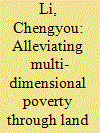

|
|
|
|
|
| Summary/Abstract |
This study constructs a Ramsey–Cass–Koopmans growth model of the agricultural sector, which includes land transfer characteristics, to investigate the theoretical basis of the land transfer impact on multi-dimensional poverty, under a steady equilibrium. Using 2010, 2012, and 2014 panel data from the Mutual Aid Fund for Poverty-Stricken Villages in China, we obtained results indicating the impact of land transfer on multi-dimensional poverty, based on the generalized propensity score method. The research results are as follows: (1) The intensity of rural households' land transfer in poverty-stricken villages remains low, at only 14.54%; however, it demonstrates an increasing trend. (2) When the intensity of land transfer is continuously enhanced, the multi-dimensional poverty of rural households in poverty-stricken villages decreases. (3) Rural households' land transfer in poverty-stricken villages can reduce multi-dimensional poverty by improving their savings behavior. “Precautionary savings motivation” is an important land transfer mechanism affecting rural households' multi-dimensional poverty in poverty-stricken villages.
|
|
|
|
|
|
|
|
|
|
|
|
|
|
|
|
| 3 |
ID:
178436
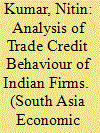

|
|
|
|
|
| Summary/Abstract |
Trade credit transactions are quite common for businesses. The article carries out the trade credit analysis for an emerging economy, namely Indian corporate sector employing rich information dataset covering multiple industries such as manufacturing, services, construction and others, since the period of financial crisis including both firm specific and macro-economic factors. The annual dataset spans 13 years from 2006 to 2018 covering the crisis period. Applying dynamic panel framework, it is found that the inventory management and macro indicators are significant in determining trade credit for Indian firms. While trade payable is chiefly driven by raw material inventory, firms having reasonable stock of raw or finished goods inventory are less likely to offer trade credit. Large-sized firms are found to be both leading consumers and suppliers of the trade credit. The pecking order theory is clearly validated with net profits being preferred over the trade credit that is a more expensive source of finance. Credit from formal financial sources is found to act as a substitute to trade credit borrowing.
|
|
|
|
|
|
|
|
|
|
|
|
|
|
|
|
| 4 |
ID:
149943


|
|
|
|
|
| Summary/Abstract |
The Covenant of Mayors (CM) is an initiative by which towns, cities and regions voluntarily commit to reduce their CO2 emissions beyond the European Union climate targets, through policies promoting energy saving and renewable energy. The aim of this paper is to analyze whether joining the CM is reducing municipalities' electricity consumption, and therefore their emissions. For this purpose, the evolution of total, household and public administration electricity consumption from 2001 to 2012 is analyzed by using panel data econometric techniques. This analysis is made for municipalities in Andalusia, the region of Spain with more signatories. Obtained results show that the CM is having a positive effect on the electricity consumption reductions, since the municipalities have greater rates of reduction of electricity consumption after signing the CM. Therefore, it may be considered appropriate to promote policies which incentivize the municipalities to join the CM and develop their action plans, as this can reduce their electricity consumption.
|
|
|
|
|
|
|
|
|
|
|
|
|
|
|
|
| 5 |
ID:
132644


|
|
|
|
|
| Publication |
2014.
|
| Summary/Abstract |
This paper explores the causal relationship between economic growth, trade openness and energy consumption using data of 15 Asian countries. The study covers the period of 1980-2011. We have applied panel cointegration and causality approaches to examine the long-run and causal relationship between variables.
Empirical results confirm the presence of cointegration between variables. The impact of economic growth and trade openness on energy consumption is found to be positive. The panel Granger causality analysis reveals the bidirectional causality between economic growth and energy consumption, trade openness and energy consumption.
|
|
|
|
|
|
|
|
|
|
|
|
|
|
|
|
| 6 |
ID:
109643
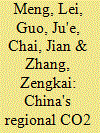

|
|
|
|
|
| Publication |
2011.
|
| Summary/Abstract |
This paper analyzes the characteristics of China's regional CO2 emissions and effects of economic growth and energy intensity using panel data from 1997 to 2009. The results show that there are remarkable regional disparities among eastern, central and western areas, regional elasticities of per capita GDP and energy intensity on CO2 emissions, which reflect the regional differences in economic development, economy structure and restraining function of energy intensity decrease on the emission. Energy intensity reducing is more effective to emission abatement for provinces with higher elasticity of energy intensity, but may not be significant for provinces with lower elasticity. The inverse distribution of energy production and consumption, regional unfairness caused by institutional factors like energy price and tax system result in inter-regional CO2 emission transfer embodied in the power transmission. The calculation indicates that the embodied emission transfer was gradually significant after 2003, from eastern area to the central and western areas, especially energy production provinces in central area, which leads to distortion on the emission and emission intensity. The regional emission reduction targets and supporting policies should be customized and consistent with the actual situations rather than setting the same target for all the provinces.
|
|
|
|
|
|
|
|
|
|
|
|
|
|
|
|
| 7 |
ID:
173768


|
|
|
|
|
| Summary/Abstract |
By facilitating the flow of information in society, communications technology (CT; e.g., newspapers, radio, television, the Internet) can help terrorists to (i) spread their message, (ii) recruit followers, and (iii) coordinate among group members. However, CT also facilitates monitoring and arresting terrorists. This article formulates the hypothesis that a society’s level of CT is systematically related to terrorism. We introduce a simple theoretical framework, suggesting that terrorism first becomes more attractive with a rise in CT, but then decreases, following an inverted U shape. Accessing data for 199 countries from 1970 to 2014, we find evidence consistent with these predictions: terrorism peaks at intermediate ranges of CT and corresponding magnitudes are sizable. Our estimations control for a range of potentially confounding factors, as well as country fixed effects and year fixed effects. Results are robust to a battery of alternative specifications and placebo regressions. We find no evidence of a potential reporting bias explaining our findings.
|
|
|
|
|
|
|
|
|
|
|
|
|
|
|
|
| 8 |
ID:
186433
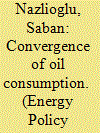

|
|
|
|
|
| Summary/Abstract |
Growing concerns about long-run equilibrium in the oil market have focused on understanding the time path of oil consumption across countries. This study examines the convergence of oil consumption across the largest oil consumers. To this end, we employ the historical oil consumption data dating back to 1890 by benefiting from the newly proposed convergence concepts, including relative/club convergence and weak -convergence, in addition to the conventional β-convergence notion. The empirical results provide new and insightful findings. First, considering common factors in the dynamics of oil consumption leads to convergence. Second, the overall evidence of absolute convergence has been at work among countries mainly before the great depression 1890–1929, while divergence occurs after the mid of 1990s. Third, the divergence observed over the last decades persists even after accounting for either a relative or weak form of convergence, supporting the primary role of the current dynamics in world oil markets. Divergence calls for stricter energy transition policies. Moreover, the clustering algorithm identifies unique convergent clubs, indicating that a unified energy policy is not tenable.
|
|
|
|
|
|
|
|
|
|
|
|
|
|
|
|
| 9 |
ID:
183620
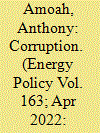

|
|
|
|
|
| Summary/Abstract |
Increasingly, a significant part of the literature on corruption establishes a negative relationship between corruption and economic variables. However, empirical research showing the influence of corruption on renewable energy consumption is useful because of the global interest in achieving a low-carbon and clean environment. In this light, we model a relationship between corruption and renewable energy consumption (% of total final energy consumption) in Africa. Using a panel dataset for 32 African countries covering the period 1996–2019, we first show that perception about corruption is relatively high in Africa. In line with corruption theory, both Generalized Method of Moments and Instrumental Variable estimation techniques are used to establish that corruption is inimical to the share of renewable energy consumption in total final energy consumption in Africa. To investigate the robustness of the results, we disaggregate the sample into high and low environmental performance countries as well as upper and lower-middle-income countries and still find consistent results. Our results call for strategic policies and institutional structures that seek to prevent corruption from further permeating the continent's administrative structures.
|
|
|
|
|
|
|
|
|
|
|
|
|
|
|
|
| 10 |
ID:
088467
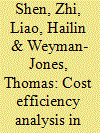

|
|
|
|
|
| Publication |
2009.
|
| Summary/Abstract |
Despite the great achievement of three decades of economic reform, the Chinese banking sector takes the blame for its dysfunctional system, especially the large amount of non-performing loans. The ease of foreign banks' entry set by the WTO from December 2007 raises our concern of the capability of domestic banks to compete against foreign Asian banks. This study attempts to address this issue by measuring the cost efficiency of ten major Asian banking industries from 1998 to 2005 using panel data stochastic frontier approaches. Based on our preferred consistent panel data estimating models, the higher cost efficiency score from including cross-country environmental variables suggests that differences between countries can explain part of the inefficiency. We also find that the overall cost efficiency level of Chinese commercial banks ranks in the fifth place, suggesting that Chinese banks still need to strengthen their ability in competition. Some policy implications are also suggested
|
|
|
|
|
|
|
|
|
|
|
|
|
|
|
|
| 11 |
ID:
123334
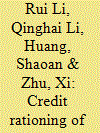

|
|
|
|
|
| Publication |
2013.
|
| Summary/Abstract |
We examined the impact of credit rationing on the net income and consumption of Chinese rural households by studying survey panel data from 1000 Chinese rural households from 2003 to 2009. Our results revealed that 61.5% of Chinese rural households were rationed in the credit market; 52.0% were completely rationed and 9.5% were partially rationed. Furthermore, this credit rationing caused a 15.7% loss in net income and an 18.2% loss in consumption expenditure for these rural households in China.
|
|
|
|
|
|
|
|
|
|
|
|
|
|
|
|
| 12 |
ID:
116060


|
|
|
|
|
| Publication |
2012.
|
| Summary/Abstract |
Over the last 30?years, there has been an impressive amount of empirical work on the defence-growth nexus, using different methodologies, models and econometric techniques and focusing on individual case studies, cross-country studies or panel data studies. Despite the number and the variety of studies, the evidence on the defence-growth relationship is still far from conclusive. Rather surprisingly, very limited work has been published in the relevant literature for the European Union despite the continuous discussions for a Common European Defence Policy that would require an assessment of the economic effects of defence in this region. To fill in the gap in the literature, this paper employs an augmented Solow-Swan model and estimates it both with panel and time series methods to provide empirical evidence on the economic effects of defence spending in the EU15 over the period 1961-2007. Overall, evidence derived from both panel and time series methods is consistent and suggests that military burden does not promote economic growth in this region.
|
|
|
|
|
|
|
|
|
|
|
|
|
|
|
|
| 13 |
ID:
162243
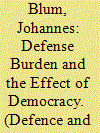

|
|
|
|
|
| Summary/Abstract |
Do democracies spend less on national defense? This paper provides new evidence of the effect of democracy on defense burden based on a Spatial Durbin Model with panel data for 98 countries for the years 1992–2008. While democracy measured by means of an index variable covering the entire range from perfect democracy to perfect autocracy turns out to be insignificant, dummy variables indicating transition to higher levels of democracy reveal a statistically highly significant negative effect of democracy on a country’s defense burden. Allowing for country-specific effects reveals heterogeneity in the effect of democracy across countries. Apart from the effect of democracy, the estimation results indicate strong spatial dependence of military burdens across countries. Moreover, they provide statistical evidence for a peace dividend, for substitution effects in defense spending and for a negative effect on the military burden for countries when they exhibit a trade surplus instead of a trade deficit.
|
|
|
|
|
|
|
|
|
|
|
|
|
|
|
|
| 14 |
ID:
129496


|
|
|
|
|
| Publication |
2014.
|
| Summary/Abstract |
This study analyzes the determinants of arms production in 15 countries using annual panel data from 1997 to 2002. The results suggest that real GDP per capita, military expenditures, arms exports, and arms imports are positively related to arms production.
|
|
|
|
|
|
|
|
|
|
|
|
|
|
|
|
| 15 |
ID:
110182


|
|
|
|
|
| Publication |
2012.
|
| Summary/Abstract |
We analyze how the determinants of the civil conflict in Colombia at the municipal level respond to changes in the empirical strategy. We estimate several econometric models that vary in three dimensions: 1) the data set, 2) the measure of conflict, and 3) the estimation method. We find substantial differences in the signs and statistical significance of the marginal effects in response to using a different data set, changing the definition of conflict, and employing different empirical methodologies.
|
|
|
|
|
|
|
|
|
|
|
|
|
|
|
|
| 16 |
ID:
162554


|
|
|
|
|
| Summary/Abstract |
Anecdotal evidence offers conflicting views on the impact of globalisation on military expenditure. We contribute to the existing literature by investigating the effect of globalisation on military expenditure in 82 countries for the period, 1989–2012. After introducing economic and strategic variables into the model, we utilise the dynamic panel generalised method of moments system to estimate the relationship in the variables. The empirical findings reveal that globalisation reduces both military burden and real military expenditure. The findings are consistent, irrespective of the globalisation indicator adopted. The policy implications of the results are explained.
|
|
|
|
|
|
|
|
|
|
|
|
|
|
|
|
| 17 |
ID:
113443
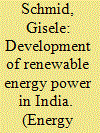

|
|
|
|
|
| Publication |
2012.
|
| Summary/Abstract |
The International Energy Agency has identified the development of renewable energy sources as a key element to mitigate climate change. At the same time it has projected India to be the second-largest contributor to the increase in global energy demand to 2035. India hence faces a significant challenge to ensure its energy security by diversifying its power generation mix. In the wake of the creation of a Green Climate Fund in Cancun, this paper studies empirically the effect of the introduction of the Electricity Act 2003 and the Tariff Policy 2006, as well as the implementation of feed-in tariffs and minimum quotas on clean electricity sourcing, on the development of grid-connected renewable energy power in nine Indian States over the period 2001-2009. Results suggest that the passing of the Tariff Policy 2006, state-level policies, quantity-based instruments and a greater participation of the private sector have played a key role in promoting the development of installed capacity from renewable energy power in the nine States of the sample.
|
|
|
|
|
|
|
|
|
|
|
|
|
|
|
|
| 18 |
ID:
159056
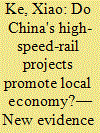

|
|
|
|
|
| Summary/Abstract |
This paper evaluates the effect of High Speed Rail (HSR) projects on the economic growth of targeted city nodes (HSR cities) in China using prefectural-level city data from 1990 to 2013. Employing a panel data program evaluation method devised by Hsiao, Ching, and Wan (2012), we construct hypothetical counterfactuals for per capita real GDP of HSR cities in the absence of their respective HSR projects using the outcomes in selected non-HSR cities. We find that the responses to HSR treatment are heterogeneous with regard to location, route, and region. The location-level impact ranges between 5% and 59% and is not temporary. HSR cities with positive effects concentrate along the Hu-Ning Segment, the Yong-Tai-Wen-Fu-Xia Segment, and within the Hunan province along the Wu-Guang HSR. These cities are mainly located in the eastern coastal regions of China, in core urban agglomeration regions that allow them to be transportation hubs. In general, the gain for local economies is greater for cities that are more industrialized, with more ability of the service sector to absorb enough labor, and with better supporting infrastructure. On the other hand, local protectionism hampers the development of HSR cities. We also show that at different project stages, HSR cities experience different gains.
|
|
|
|
|
|
|
|
|
|
|
|
|
|
|
|
| 19 |
ID:
121298


|
|
|
|
|
| Publication |
2013.
|
| Summary/Abstract |
This paper uses the generalized method of moments (GMM) estimation to a panel data error correction model (ECM) in order to measure the asymmetries in the transmission of shocks to input prices and exchange rate onto the wholesale and retail gasoline price, respectively. For this purpose, we use an updated data set of 6369 weekly observations (January 2000 to February 2011) for 11 euro zone countries. The results indicate the existence of asymmetric responses in the retail and wholesale segment due to possible reasons (oligopolistic structure of the refining industry, existence of consumers search costs, regulatory and legal barriers).
|
|
|
|
|
|
|
|
|
|
|
|
|
|
|
|
| 20 |
ID:
166577
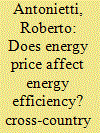

|
|
|
|
|
| Summary/Abstract |
In this paper, we analyze the relationship between energy intensity and energy price in a panel of 120 countries over 34 years, from 1980 to 2013. We use information on energy intensity and real oil price, and merge it with macroeconomic data on the countries' structural characteristics. We assess their long-run relationship and direction of causality using panel cointegration tests and dynamic panel data models. We identify a statistically significant, but weak negative effect of real oil price on energy intensity, which corresponds to a positive effect of energy price on energy efficiency. We also show significant, large regional differences in this relationship. We thus posit that a global policy aimed at increasing the price of oil would induce a limited increase in average energy efficiency through a more efficient use of energy, but this increase would differ considerably across regions around the world.
|
|
|
|
|
|
|
|
|
|
|
|
|
|
|
|
|
|
|
|
|